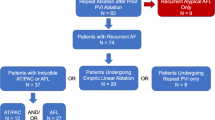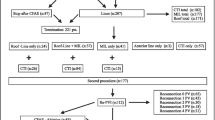Abstract
Purpose
The presence of inducible atrial tachyarrhythmia after pulmonary vein isolation (PVI) during radiofrequency catheter ablation (RFCA) for persistent atrial fibrillation (AF) may indicate the necessity of further substrate modification, but the optimal ablation endpoint is unknown. We sought to assess the impact of procedural termination of inducible atrial tachyarrhythmia after PVI in comparison with continued atrial tachyarrhythmia after PVI.
Methods
Among patients who underwent RFCA for persistent AF, we enrolled 93 patients who were in sinus rhythm after PVI and had inducible atrial tachyarrhythmia and 157 patients with continued atrial tachyarrhythmia after PVI. The impact of acute arrhythmia termination during further substrate modification on recurrence was compared between the two groups.
Results
Acute termination was achieved in 51 (54.8%) patients in the induced arrhythmia group and 61 (38.9%) in the continued arrhythmia group. During a mean 35.8 months, acute termination did not significantly reduce arrhythmia recurrence in the induced arrhythmia group (HR 0.712, 95% CI 0.400–1.266, p = 0.247), while it was associated with improved outcome in the continued arrhythmia group (HR 0.590, 95% CI 0.355–0.979, p = 0.038). Acute termination of either induced atrial tachycardia (AT) or induced AF was not associated with improved procedure outcome. Among the continued arrhythmia group, the benefit of acute termination was statistically significant in AT (HR 0.329, 95% CI 0.108–0.997, p = 0.039), but not in AF (HR 0.704, 95% CI 0.396–1.253, p = 0.233) after PVI.
Conclusions
Acute termination of induced rhythm is not a reliable ablation endpoint during substrate modification in patients with inducible arrhythmia after PVI.




Similar content being viewed by others
References
Pappone C, Rosanio S, Oreto G, Tocchi M, Gugliotta F, Vicedomini G, et al. Circumferential radiofrequency ablation of pulmonary vein ostia: a new anatomic approach for curing atrial fibrillation. Circulation. 2000;102:2619–28.
Haissaguerre M, Jais P, Shah DC, Takahashi A, Hocini M, Quiniou G, et al. Spontaneous initiation of atrial fibrillation by ectopic beats originating in the pulmonary veins. N Engl J Med. 1998;339:659–66.
Calkins H, Hindricks G, Cappato R, Kim YH, Saad EB, Aguinaga L, et al. HRS/EHRA/ECAS/APHRS/SOLAECE expert consensus statement on catheter and surgical ablation of atrial fibrillation. Heart Rhythm. 2017;14:e275–444.
Tilz RR, Rillig A, Thum AM, Arya A, Wohlmuth P, Metzner A, et al. Catheter ablation of long-standing persistent atrial fibrillation: 5-year outcomes of the Hamburg sequential ablation strategy. J Am Coll Cardiol. 2012;60:1921–9.
Schreiber D, Rostock T, Frohlich M, Sultan A, Servatius H, Hoffmann BA, et al. Five-year follow-up after catheter ablation of persistent atrial fibrillation using the stepwise approach and prognostic factors for success. Circ Arrhythm Electrophysiol. 2015;8:308–17.
Brooks AG, Stiles MK, Laborderie J, Lau DH, Kuklik P, Shipp NJ, et al. Outcomes of long-standing persistent atrial fibrillation ablation: a systematic review. Heart Rhythm. 2010;7:835–46.
Scherr D, Khairy P, Miyazaki S, Aurillac-Lavignolle V, Pascale P, Wilton SB, et al. Five-year outcome of catheter ablation of persistent atrial fibrillation using termination of atrial fibrillation as a procedural endpoint. Circ Arrhythm Electrophysiol. 2015;8:18–24.
Ammar S, Hessling G, Reents T, Paulik M, Fichtner S, Schon P, et al. Importance of sinus rhythm as endpoint of persistent atrial fibrillation ablation. J Cardiovasc Electrophysiol. 2013;24:388–95.
Park YM, Choi JI, Lim HE, Park SW, Kim YH. Is pursuit of termination of atrial fibrillation during catheter ablation of great value in patients with longstanding persistent atrial fibrillation? J Cardiovasc Electrophysiol. 2012;23:1051–8.
Bassiouny M, Saliba W, Hussein A, Rickard J, Diab M, Aman W, et al. Randomized study of persistent atrial fibrillation ablation: ablate in sinus rhythm versus ablate complex-fractionated atrial electrograms in atrial fibrillation. Circ Arrhythm Electrophysiol. 2016;9:e003596.
Haissaguerre M, Sanders P, Hocini M, Hsu LF, Shah DC, Scavee C, et al. Changes in atrial fibrillation cycle length and inducibility during catheter ablation and their relation to outcome. Circulation. 2004;109:3007–13.
Murakawa Y, Nogami A, Shoda M, Inoue K, Naito S, Kumagai K, et al. Nationwide survey of catheter ablation for atrial fibrillation: the Japanese Catheter Ablation Registry of Atrial Fibrillation (J-CARAF). Circ J. 2014;78:1091–6.
Verma A, Jiang CY, Betts TR, Chen J, Deisenhofer I, Mantovan R, et al. Approaches to catheter ablation for persistent atrial fibrillation. N Engl J Med. 2015;372:1812–22.
Vogler J, Willems S, Sultan A, Schreiber D, Luker J, Servatius H, et al. The CHASE-AF clinical trial. J Am Coll Cardiol. 2015;66:2743–52.
Oral H, Chugh A, Lemola K, Cheung P, Hall B, Good E, et al. Noninducibility of atrial fibrillation as an end point of left atrial circumferential ablation for paroxysmal atrial fibrillation: a randomized study. Circulation. 2004;110:2797–801.
Chang SL, Lin YJ, Tai CT, Lo LW, Tuan TC, Udyavar AR, et al. Induced atrial tachycardia after circumferential pulmonary vein isolation of paroxysmal atrial fibrillation: electrophysiological characteristics and impact of catheter ablation on the follow-up results. J Cardiovasc Electrophysiol. 2009;20:388–94.
Richter B, Gwechenberger M, Filzmoser P, Marx M, Lercher P, Gossinger HD. Is inducibility of atrial fibrillation after radio frequency ablation really a relevant prognostic factor? Eur Heart J. 2006;27:2553–9.
Leong-sit P, Robinson M, Zado ES, Callans DJ, Garcia F, Lin D, et al. Inducibility of atrial fibrillation and flutter following pulmonary vein ablation. J Cardiovasc Electrophysiol. 2013;24:617–23.
Nagamoto Y, Park JS, Tanubudi D, Ko YK, Ban JE, Kwak JJ, et al. Clinical significance of induced atrial tachycardia after termination of longstanding persistent atrial fibrillation using a stepwise approach. J Cardiovasc Electrophysiol. 2012;23:1171–8.
O'Neill MD, Wright M, Knecht S, Jais P, Hocini M, Takahashi Y, et al. Long-term follow-up of persistent atrial fibrillation ablation using termination as a procedural endpoint. Eur Heart J. 2009;30:1105–12.
Drewitz I, Willems S, Salukhe TV, Steven D, Hoffmann BA, Servatius H, et al. Atrial fibrillation cycle length is a sole independent predictor of a substrate for consecutive arrhythmias in patients with persistent atrial fibrillation. Circ Arrhythm Electrophysiol. 2010;3:351–60.
Heist EK, Chalhoub F, Barrett C, Danik S, Ruskin JN, Mansour M. Predictors of atrial fibrillation termination and clinical success of catheter ablation of persistent atrial fibrillation. Am J Cardiol. 2012;110:545–51.
Acknowledgements
We would like to thank Seo Seung-Duk, Abbott Cardiac Rhythm Management Division, for his efforts in literature review and correction of the paper.
Author information
Authors and Affiliations
Corresponding authors
Ethics declarations
Conflict of interest
None declared.
Rights and permissions
About this article
Cite this article
Choi, Y., Kim, SH., Kim, J.Y. et al. Utility of acute arrhythmia termination as an ablation endpoint for induced atrial tachyarrhythmia after complete pulmonary vein isolation during catheter ablation for persistent atrial fibrillation. J Interv Card Electrophysiol 54, 25–34 (2019). https://doi.org/10.1007/s10840-018-0436-x
Received:
Accepted:
Published:
Issue Date:
DOI: https://doi.org/10.1007/s10840-018-0436-x




